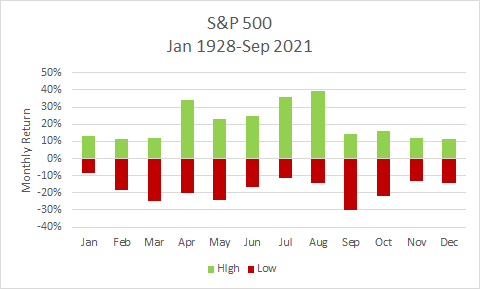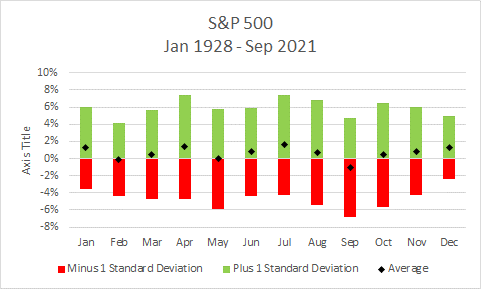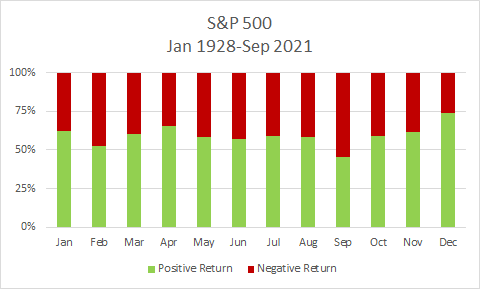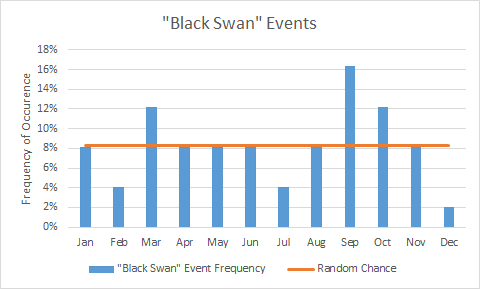Darkness arrives sooner these days. The air is cooler. Our neighborhood is slowly populating with ghosts and skeletons. It is not just trick-or-treaters doing the frightening. October has been a scary month for the stock market. In 2008, the S&P 500 fell -17%. In 1929, the S&P 500 fell -20%. And, in 1987, the S&P 500 fell -22%. Should these extreme monthly returns cause us to fear the month of Halloween in the equity market? We looked at the S&P 500 back to 1928.
How volatile is the tenth month of the year? There are a few ways to answer that question. One is the range of returns (the highest minus the lowest). As noted above, the worst October was 1987 at -22%. The best October was in 1974 at +16%. So, the range of returns for the month has been 38%. Is this the widest? No. April, which experienced -20% in 1932 and +34% in 1933, is the standout. The narrowest? January, -9% in 2009 and +13% in 1987, holds that title. October is #7.

A second volatility measure is standard deviation. This calculation describes how much dispersion there has been around the average of a data set. The average October return has been 0.44%, and the month has had the second highest standard deviation at 6.06%. The most volatile month by this definition is August with an average return of 0.70% and a standard deviation of 6.11%. February has been the most docile month with an average return of -0.11% and a standard deviation of 4.26%.
As an aside, should we avoid February with its negative average return? No. Averages can be skewed by extreme observations (aka outliers). It is more useful to look at the median or midpoint of the data. This value has the same number of data points below and above it. The median return for February is 0.27%.

How often has October delivered a negative return? Forty one percent of the time. The worst success rate has been in September with 54% of observations negative. The best chance of a positive return historically has come in December when just 26% of years had negative returns.

So, is April the worst because its return range is the widest? Is August, which has the highest standard deviation to be feared? Or is September the bogeyman with the lowest historical success rate?
Volatility cuts both ways, but the focus tends to be on the downside. April has had a wide range of returns. The market was down -20% in 1932; but, trying to sidestep a potential repeat in 1933 would have foregone the +34% monthly return.
In the past, August has had the most noise around its average return of 0.70%. That noise comes from below and above average returns. Returns that come in unexpectedly above the expectations are not “risky”. August accounted for 1 of the 20 worst monthly returns (-15% in 1998) and 3 of the 20 best monthly returns (+11% in 1933, +12% in 1982, and +39% in 1932).
Lastly, simply looking at success rates doesn’t factor in the magnitude of returns. A month could post several small negative returns, which would make it seem “risky”, but missing the rare strong positive month could do more damage.
An extreme data point, sometimes known as a “black swan” event, can be defined as an observation beyond two standard deviations. Statistics tells us that approximately 4.5% of observations should meet this criterion. The average of all the months is 0.63% and the standard deviation is 5.37%. The expectation would be that 95.5% of observations would lie between 0.63% +/- (5.37%)(2) or -10.11% to +11.38%.
In fact, 49 of 1,125 observations (4.4%) meet black swan criteria. Six of the 49 (or 12%) occurred in Octobers. On this basis, October should be no scarier than March and less frightening than September. Interestingly, October is only a bit more volatile than random chance (1/12) would predict.

Assume now that October does produce a negative black swan event (as it inevitably will again sometime in the future), how long has the market needed to recover in the past? On average, a recovery from an October loss took 87 months! The median recovery time was 21 months (see above for average vs. median). The data is skewed by the 297 months it took to recover from October 1929. The fastest recovery from an October crash was 8 months (after October 1932).
The data shows that trying to use a calendar to forecast market returns won’t be productive. Investment theory has long noted this. At Trust Company of the South, market efficiency is part of the philosophy. This is the concept that security prices reflect publicly available information. The history of the S&P 500 is readily available to almost anyone. As such, trying to use this data to one’s advantage to predict a market move will be fruitless. Any value from that information has already been considered in security prices and investors’ expectations. Rather than panic or prepare for an autumn decline, enjoy the beautiful weather, and decorate for Halloween.